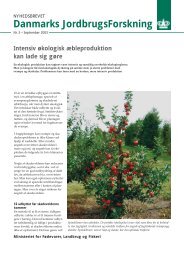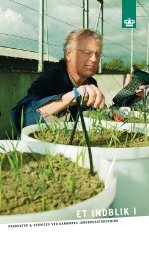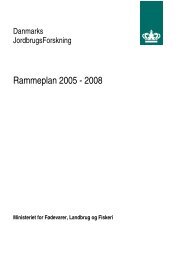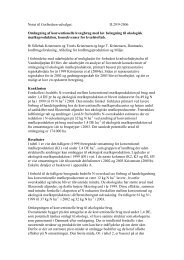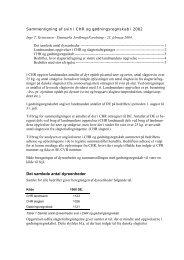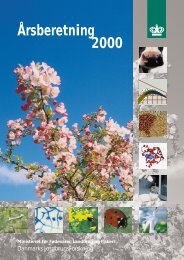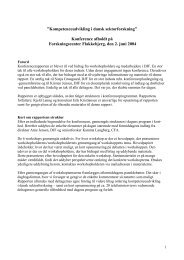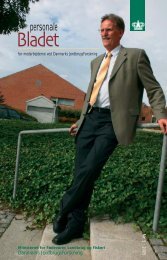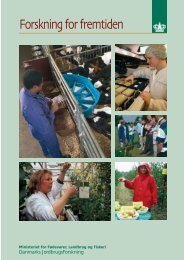Reproduction performances and conditions of group-housed non ...
Reproduction performances and conditions of group-housed non ...
Reproduction performances and conditions of group-housed non ...
Create successful ePaper yourself
Turn your PDF publications into a flip-book with our unique Google optimized e-Paper software.
- Paper IV -<br />
ing compared to number <strong>of</strong> recordings (max 50) was calculated for each sow (% not eating).<br />
Three fear tests were performed as indicators <strong>of</strong> fear. One Human Approach test (HA-test)<br />
were performed when sows were routinely moved at weaning (Rousing et al., 1999; Bonde<br />
et al., 2003). The sow had to pass a human (research technician) at a passage <strong>of</strong> 10 metres<br />
long <strong>and</strong> about one meter wide. The human was placed halfway. If the relation between the<br />
time required to approach the person compared to the total time required to pass the 10 metres<br />
were more than 0.67 then the sow was categorised as fearful. Two Forced Human Approach<br />
tests (FHA-tests) were performed in the home arena <strong>of</strong> the sows (Andersen et al.,<br />
2003, Pedersen et al., 2003) three weeks after mating. The sows’ reaction was categorised<br />
into reaction 1 to 6 <strong>and</strong> 1 to 3 respectively with low score indicating fleeing behaviour.<br />
Only sows, which scored 1 or 2 in the first <strong>and</strong> 1 in the second test, were categorised as<br />
fearful.<br />
Involvements in aggressive interactions, skin lesions <strong>and</strong> lying behaviour during resting<br />
periods were used as indicators <strong>of</strong> stress. The total number <strong>of</strong> aggressive interactions the<br />
individual sow participated in together with the number <strong>of</strong> lost interactions the first hour<br />
after weaning was recorded. The total number <strong>of</strong> skin lesions on head, ears, neck <strong>and</strong><br />
shoulders were recorded for each sow at mating <strong>and</strong> three weeks after. Every five minute<br />
during resting period at weaning <strong>and</strong> three weeks after mating for 25 minutes, it was registered<br />
whether the sow was lying solitary (defined as lying/sitting in a distance <strong>of</strong> 20 cm or<br />
more from other sows) or socially. If the sow was lying alone more frequently than socially,<br />
the sow was categorised as lying solitary.<br />
2.4 Statistical analysis<br />
When analysing the effect <strong>of</strong> the indicators on the interval from weaning to first mating,<br />
pregnancy chance, culling risk <strong>and</strong> litter size, the following model was applied:<br />
E(Yijk)= µ+αI(ijk)+γI(ijk) W +γI(ijk) AM +δI(ijk) W +δI(ijk) AM + Ai + Bi(j)+<br />
91<br />
7<br />
∑<br />
u=1<br />
βu xuijk<br />
Where Yijk is the observation for herd i, batch j <strong>and</strong> sow k. αI(ijk) is the effect <strong>of</strong> parity <strong>group</strong><br />
I(ijk) (1, 2-3 <strong>and</strong> >3 parity). I(ijk) is an indicator function given the parity <strong>of</strong> observation<br />
ijk. The indicator functions are specific to each effect, however, to keep Eq. (1) as simple as<br />
possible this I() notation is used throughout. γI(ijk) W <strong>and</strong> γI(ijk) AM is the effect <strong>of</strong> fear category<br />
(j,k =fearful, confident) at weaning <strong>and</strong> three weeks after mating respectively, δI(ijk) W <strong>and</strong><br />
δI(ijk) AM the effect <strong>of</strong> lying behaviour (l,m=lying solitary, lying socially) at weaning <strong>and</strong><br />
(1)




